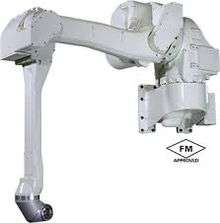Paint robot
Industrial paint robots have been used for decades in automotive paint applications from the first hydraulic versions - which are still in use today but are of inferior quality and safety - to the latest electronic offerings.[1][2][3] The newest robots are accurate and deliver results with uniform film builds and exact thicknesses.


Originally industrial paint robots were large and expensive, but today the price of the robots have come down to the point that general industry can now afford to have the same level of automation that only the big automotive manufacturers could once afford.
The selection of today’s paint robot varies much more in size and payload to allow many configurations for painting items of all sizes. The prices vary as well as the new robot market becomes more competitive and the used market continues to expand.
Painting robots generally have five or six axis motion, three for the base motions and up to three for applicator orientation. These robots can be used in any explosion hazard Class 1 Division 1 environment.